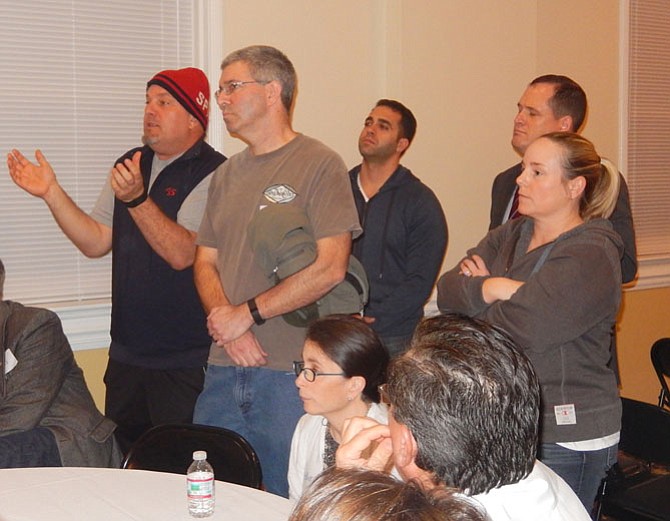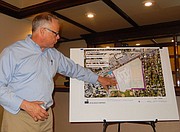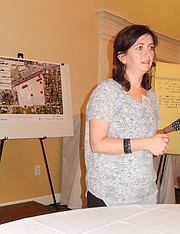John Norce, in red cap, suggested connecting Cedar Avenue, but restricting its hours of use and traffic flow. Photo by Bonnie Hobbs.
The firm that will redevelop the current site of Paul VI High School continues to seek the opinions of the surrounding residents. And at the March 10 meeting, they weren’t shy about speaking up.
In a group discussing transportation and mobility, Ellen Brouwer said, “We want to slow down the traffic and keep it from coming through our neighborhoods. So I’d suggest your traffic needs to stay on your site.”
“Walnut and Second Street folks wanted a connection at Cedar Avenue so they could get some relief,” replied transportation consultant Chris Turnbull. “And having more connections helps disburse the traffic. You have to have a road network, not just an entrance.”
John Norce suggested connecting Cedar, but with time restrictions to control the hours and flow of traffic. “Otherwise, you’re forcing all that traffic to come into our Second Street and Oak Street side,” he said. “Or close Cedar Avenue completely, at McLean and open up Keith Avenue.”
“We’re faced with a significant number of housing units in a very small area, not just from you,” continued Norce. “You should make a pipestem off Oak in front of Panther Place by the Montessori school. You could use it for parking for Pat Rodio Park and nearby residences.”
Turnbull said traffic there might decrease once the school leaves, but the residents were skeptical. So, he assured them, “We’ll include the other developments’ anticipated traffic in our traffic study.”
Colin Greene, with the design team, also got some push-back from the attendees. One woman objected to the proposed building heights. She said two- or three-story buildings would “overpower that side of the street. And the same thing with the four- to six-story buildings [proposed along Fairfax Boulevard]. That’s very scary; they shouldn’t be higher than the existing buildings.”
But Enrico Cecchi, representing developer IDI Group Cos., said five stories are about 60 feet high, and 60 feet is “currently the allowed height on that site, by right.”
Furthermore, added Greene, “Fairfax Boulevard is a major commercial center in Fairfax. And retail – or a place where the community could go – is most viable at an intersection with high visibility and a turn-in. This map [showing the proposed construction zones for the property] just shows where we think these things would work.”
Still, residents were concerned because McLean, Cedar and Keith avenues consist of single-family homes, and they want the new homes to be built near them to not be high-density. Steve Oldfield, who’s lived on Cedar for 25 years, said, “I strongly ask for single-family homes along McLean and Cedar to reflect the existing neighborhoods.”
Another man asked why mixed-use is planned, and Greene said, “We’ll put all the uses on the table and see what actually works on this site. Mixed-use allows people to live, work and play within a walk or a short car drive.”
Dee Schmidt asked why the site designers were considering the median as open space, and Greene explained that “It’s more of a buffer and a transition zone; it’s a [place] where there’s not a building, so it’s a public-serving space.”
Civil engineer Bill Zink discussed the site features. “We’re mapping the site and looking at existing conditions to submit the documents for zoning and for infrastructure construction,” he said. “We also locate and map all the utilities.”
To residents worried about the current flooding on the property, he said, “The stormwater will be treated for water quality and we’ll reduce the rate at which it flows off the site. We’re required to treat the water so less of it will flow off the site than today.”
Zink said residents on McLean, Keith and Cedar reported having drainage problems, “So we’ve proposed frontage improvements.” Besides that, he said, “We think pedestrian connectivity through the site is important. [But] some people do and do not want sidewalks along Keith Avenue.”
“On Cedar Avenue, one of the City’s oldest streets, we don’t have curb and gutter – and we like it that way,” replied Oldfield. “It makes it eclectic and gives it character.”
Meanwhile, property-history consultant Anna Maas spoke about the land and the building’s significance. Initially housing Fairfax High, the building’s first part was constructed in 1934 and opened in 1935. Paul VI has been there since 1983. But the land wasn’t always a site for education. It was once a dairy farm, as well as a fairgrounds.
“We’re looking at different ways to celebrate the property’s history,” said Maas. “And we could use the building’s façade in something that’s two to three stories.”
Cynthia Cute said she’d like large portions of Paul VI’s building preserved. And, she added, “I don’t think 4-6 story buildings near it will be helpful.”
“It’ll depend on the largest feedback we get,” said Maas. “We’ll weigh everything against the community’s needs that people are telling us about. And if we’re looking at re-use, we’re looking at the oldest portion. Most people said they wanted the main part of the building – the auditorium, kitchen, gym and classrooms to be saved. [However], this is very preliminary to get the community’s feedback.”


